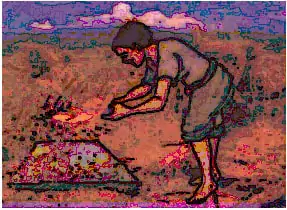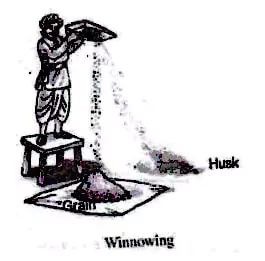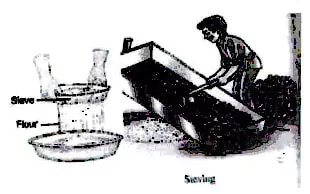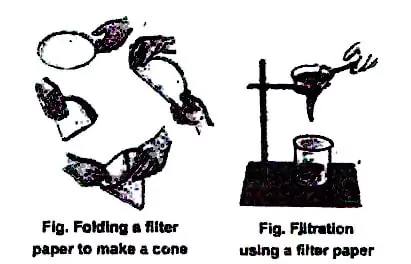INTRODUCTION
There are many instances when we notice a substance being separated from a mixture of materials. Tea leaves are separated from the liquid with a strainer, while preparing tea. Grain is separated from stalks, while harvesting. Milk or curd is churned to separate the butter.
Before we use a substance, we need to separate harmful or non-useful substances that may be mixed with it. Sometimes, we separate even useful components if we need to use them separately. The substances to be separated may be particles of different sizes or these may be solids, liquids or even gases.
METHODS OF SEPERATION
(i) Hand picking: The method of handpicking can be used for separating slightly larger sized impurities like the pieces of dirt, stone, and husk from wheat, rice or pulses. The quantity of such impurities is usually not very large. In such situations, we find that handpicking is a convenient method of separating substances.
(ii) Threshing: The process that is used to separate grain from stalks is threshing. In this process, the stalks are beaten to free the grain seeds. Sometimes, threshing is done with the help of bullocks. Machines are also used to thresh larger quantities of grain.
(iii) Winnowing: Winnowing is used to separate heavier and lighter components of a mixture by wind or by blowing air. This method Is commonly used by farmers to separate lighter husk particles from heavier seeds of
The husk particles are carried away by the wind. The seeds of grain get separated and form a heap near the platform for winnowing. The separated husk is used for many purpose such as fodder for cattle.
(iv) Sieving: In a flour mill, impurities like husk and stones are removed from wheat before grinding it. Usually, a bagful of wheat is poured on slanting sieve. Sieving
removes pieces of stones, stalk and husk that may still remain with wheat after threshing and winnowing. Similar sieves are used at construction sites to
separate pebbles and stones from sand.
(V) Sedimentation: Decantation and Filtration: Sometimes, it may not be possible to separate components of a mixture by winnowing and handpicking. For example, there may be lighter impurities like dust or soil. particles in rice or pulses. Rice or pulses are usually washed before cooking.
When you add water to these, the Impurities like dust and soil particles get separated. These impurities go into water, which becomes a little muddy.
When the heavier component in a mixture settles after water is added to it, the process is called sedimentation. When the water (along with the dust) is removed , the process is called decantation.
The same principle is used for separating a mixture of tWo liquids that do not mix with each other. For example, oil and water from their mixture can be separated by this process. If a mixture of such liquids is allowed to stand for some time, they form two separate layers. The component that forms the top layer can then be separated by decantation.
A mixture of insoluble solid and liquid can be separated by the process of filtration.
If water is muddy, impurities can be separated by a filter that has even smaller pores. A filter paper is one such filter that has very fine pores
The figure shows the steps involved in using a filter paper. A filter paper folded in the form of a cone is fixed onto a funnel. The mixture is then poured on the filter paper. Solid particles in the mixture do not pass through it and remain on the filter.
Fruit and vegetable juices are usually filtered before drinking to separate the seeds and solid particles of pulp.
(vi) Evaporation: The process of conversion of water into its vapour below its boiling point is called evaporation. The process of evaporation takes place continuously wherever water is present. Sea water contains many salts mixed in it. One of these salts Is the common salt. When sea water Is allowed to stand in shallow pits, water gets heated by sunlight and slowly turns into water vapour, through evaporation. In a few days , the water evaporates completely leaving behind the solid salts. Common salt is then obtained from this mixture of salts by further purification.
USE OF MORE THAN ONE METHOD OF SEPARATION
Often, one method is not sufficient to separate the different substances present in a mixture. In such a situation,’ we need to use more than one of these methods. For example: It we take a mixture of sand and salt. Handpicking would not be a practical method for separating these. In order to separate them we keep this mixture in a beaker and add some water 10 mL and leave it aside for some time. We will see the sand settling down at Ihe bottom. The sand can be separated by decantation or filtration. Now, we need to separate salt and water from Ihe decanted liquid. For this we transfer this liquid 10 a kettle and close its lid. The kettle is heated for some time. We notice steam coming oul from the spout of the kettle. Then we hold a metal plate with some ice on II just above the spoul of the kettle. Let all the water in the kettle boil off.
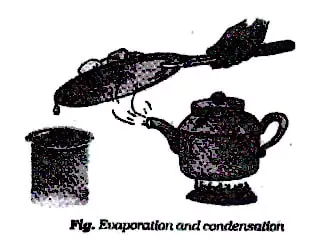
When the steam comes in the contact with the metal plate cooled with ice. it condenses and forms liquid water. The process of conversion of water vapour into its liquid form is called condensation .
After all the water has evaporated, salt is left behind in the kettle.
We have thus, separated salt, sand and water using processes of decantation , filtration, evaporation and condensation.
CAN WATER DISSOLVE ANY AMOUNT OF A SUBSTANCE
Many substances dissolve in water “and form a solution. The solution made in water are called aqueous solutions.
Activity : Pour half a cup of water in the beaker. Add one teaspoonful of salt and stir it well, until the salt dissolve completely. Again add a teaspoonful of salt and stir well. Go on adding salt, one teaspoonful at a time and stir.
After adding a few spoons of salt, we find that some salt remains undissolved and settles at the bottom of the beaker. This means that no more salt can be dissolved in the amount of water we have taken. The solution is now said to be saturated.
Now, add a small quantity of salt to this saturated solution and heat it.
We find that now salt dissolves in it. Such solution which contains more amount of substances dissolved in it than required to form a saturated solution is called super saturated solution. This hot solution cool. We notice that salt appear to settle at the bottom of the beaker again.
A solution that contains less amount of solute than required to form a saturated solution is called an unsaturated solution.
OBJECTIVE QUESTIONS
1. Technique used to separate grains from stalks is
(A) hand picking (B) threshing
(C) winnowing (D) sieving
2. The method used to separate heavier and lighter components of a mixture is
(A) hand picking (B) threshing
(C) winnowing (D) sieving
3. Sieving is used to
(A) separate impurities from wheat
(B) separate pebbles and stones from sand
(C) separate impurities from flour
(D) All of these
4. Cream is separated from milk by ______ and tea leaves are separated from tea by ____
(A) filtration , decantation
(B) winnowing, filtration
(C) decantation, filtration
(D) decantation, decantation
5. Salt is obtained from sea water by the process of
(A) filtration (B) winnowing
(C)evaporation (D) decantation
6. Grain and husk can be separated by
(A) hand picking (B) threshing
(C) winnowing (D) sieving
7. The steam when comes in contact with cold surface,. converts in water. The process is called
(A) evaporation (B) condensation
(C) sublimation (D) melting
8. The mixture of sand, salt and water can be separated by
(A) sublimation (B) filtration
(C) distillation (D) (B) followed by (C)
9. The difference between sieving and filtration is of
(A) size of particles (B) phase of particles
(C) density (D) None of these
10. Match the following
(a) Stone and rice (i) Decantation
(b)Water and rice (ii) Hand picking
(c) Water and oil (iii) Winnowing
(d) Sand and Sawdust (iv) Filtration
(A) a -iv, b -ii, c -i, d -iii
(B) a -iv, b -ii, c -iii, d -i
(C) a -i, b -ii , c -iii, d -iv
(D) a -ii, b -iv, c -i, d -iii
11. We can obtain sugar from sugar solution by -
(A) sedimentation (B) evaporation
(C) filtration (D) decantation
12. Mixture of salt and iron powder is separated by
(A) hand picking (B) magnetic sepration
(C) sleving (D) churring
13. Handpicking method can be used for separating mixture of -
(A) sugar powder and salt
(B) red and blue coloured balls of different size
(C) oil and water
(D) milk and cream
14. The process used for separating constituents while preparing fruit juice is -
(A) condensation (B) evaporation
(C) threshing (D) filtration
15. When more quantity of salt is added to saturated solution of salt, then it
(A) settles down at the bottom of the container
(B) remains suspected in the solution
(C) starts evaporating
(D) reacts with the solvent (water)
16. A solution is prepared by dissolving sodium chloride in water. It is called -
(A) non - aqueous solution
(B) aqueous solution
(C) alcoholic solution
(D) heterogeneous solution
17. Alum is used in -
(A) loading (B) filtration
(C) evaporation (D) distillation
18. The component of a solutin which is present in larger amount is referred as -
(A) sediment (B) solubility
(C) solute (D) solvent
SUBJECTIVE QUESTIONS
1. What are aqueous solution?
2. What type of mixture can be separated by filtration ?
3. Why do we need to separate different component of a mixture?
4. In solution of sugar in water, 5g of sugar is present. However at the same temperature, the same solution can hold 6.5 g of sugar. What type of solution is it?
5. What is evaporation ? How is it useful to us?
6. Name a gaseous mixture, Mention its constituents also.
7. Name any two methods, which are used to separate:
(a) Solid - solid mixtures
(b) Liquid - solid mixtures
8. Squash (Sharbat) is prepared by mixing flavoured liquid, sugar and water. You wish to add ice to it. Should the ice be added to the lemonade before or after dissolving sugar? In which case would it be possible to dissolve more sugar and why?
1 .B 2.C 3. D 4. C
5. C 6.C 7. B 8. D
9. B 10.D 11.B 12.B
13.B 14.D 15.A 16.B
17.A 18.D
1. Paheli bought some vegetables such as french beans, lady’s finger, green chillies, brinjals and potatoes all mixed in a bag. Which of the following methods of separation would be most appropriate for her to separate them?
(a) Winnowing (b) Sieving (c) Threshing (d) Hand picking
2. Boojho’s grandmother is suffering from diabetes. Her doctor advised her to take ‘Lassi’ with less fat content. Which of the following methods would be most appropriate for Boojho to prepare it?
(a) Filtration (b) Decantation (c) Churning (d) Winnowing
3. Which of the following mixtures would you be able to separate using the method of filtration?
(a) Oil in water (b) Cornflakes in milk (c) Salt in water (d) Sugar in milk
4. Which amongst the following methods would be most appropriate to separate grains from bundles of stalks?
(a) Hand picking (b) Winnowing (c) Sieving (d) Threshing
5. Four mixtures are given below
(i) Kidney beans and chick peas
(ii) Pulses and rice
(iii) Rice flakes and corn
(iv) Potato wafers and biscuits
Which of these can be separated by the method of winnowing?
(a) (i) and (ii) (b) (ii) and (iii)
(c) (i) and (iii) (d) (iii) and (iv)
6. While preparing chapatis, Paheli found that the flour to be used was mixed with wheat grains. Which out of the following is the most suitable method to separate the grains from the flour?
(a) Threshing (b) Sieving (c) Winnowing (d) Filtration
7. You might have observed the preparation of ghee from butter and cream at home. Which method(s) can be used to separate ghee from the residue?
(i) Evaporation (ii) Decantation (iii) Filtration (iv) Churning
Which of the following combination is the correct answer?
(a) (i) and (ii) (b) (ii) and (iii)
(c) (ii) and (iv) (d) (iv) only
8. In an activity, a teacher dissolved a small amount of solid copper sulphate in a tumbler half filled with water. Which method would you use to get back solid copper sulphate from the solution?
(a) Decantation (b) Evaporation (c) Sedimentation (d) Condensation
9. During summer, Boojho carries water in a transparent plastic bottle to his school. One day he left his bottle in the school. The bottle still had some water left in it. The following day, he observed
some water droplets on the inner surface of the empty portion of the bottle. These droplets of water were formed due to
(a) boiling and condensation. (b) evaporation and saturation.
(c) evaporation and condensation. (d) condensation and saturation.
10. Paheli asked for a glass of water from Boojho. He gave her a glass of ice cold water. Paheli observed some water droplets on the outer surface of the glass and asked Boojho how these droplets of water were formed? Which of the following should be Boojho’s answer?
(a) Evaporation of water from the glass. (b) Water that seeped out from the glass.
(c) Evaporation of atmospheric water vapour. (d) Condensation of atmospheric water vapour.
VERY SHORT ANSWER QUESTIONS
11. Sheela, Saima and Ravi have to dissolve maximum amount of sugar in the same amount of milk so as to win in a game. Ravi took hot boiling milk while Saima took ice cold milk. Sheela managed to get milk at room temperature. Whom do you think would win the game and why?
12. Fill in the blanks with appropriate words:
(i) Small pieces of stone can be removed from rice by __________.
(ii) ___________ are obtained from stalks by threshing.
(iii) Husk from wheat flour is generally removed by __________.
(iv) The process of settling of heavier particles is called __________.
(iv) Filtration is helpful in separating an insoluble __________from a __________.
13. State whether the following statements are true or false.
(a) A mixture of oil and water can be separated by filtration.
(b) Water can be separated from salt by evaporation.
(c) A mixture of wheat grains and wheat flour can be separated by sieving.
(d) A mixture of iron filings and rice flour can be separated by magnet.
(e) A mixture of wheat grains and rice flakes can be separated by winnowing.
(f) A mixture of tea leaves and milk can be separated by decantation.
SHORT ANSWER QUESTIONS
14. Name and describe briefly a method which can be helpful in separating a mixture of husk from grains. What is the principle of this method?
15. Match the mixtures in Column I with their method of separation in Column II.
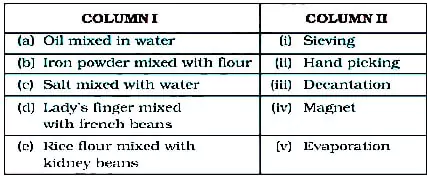
LONG ANSWER QUESTIONS
16. Both Sarika and Mohan were asked to make salt solution. Sarika was given a teaspoonful of salt and half a glass of water, whereas Mohan was given twenty teaspoons full of salt and half a glass of water.
(a) How would they make salt solutions?
(b) Who would be able to prepare saturated solution?
17. Paheli was feeling thirsty but there was only a pot of water at home which was muddy and unfit for drinking. How do you think Paheli would have made this water fit for drinking if the following materials were available to her.
Alum, tub, muslin cloth, gas stove, thread, pan and lid.
18. Read the story titled “WISE FARMER” and tick the correct option to complete the story.
A farmer was sad/happy to see his healthy wheat crop ready for harvest. He harvested the crops and left it under the sun/rain to dry the stalks. To separate the seeds from the bundles of the stalk he handpicked/threshed them. After gathering the seed grains he wanted to separate the stones and husk from it. His wife winnowed/threshed them to separate the husk and later sieved/hand picked to remove stones from it. She ground the wheat grains and sieved/
filtered the flour. The wise farmer and his wife got a good price for the flour. Can you tell why?
19. You are provided with a mixture of salt, sand, oil and water. Write the steps involved for the separation of salt, sand and oil from the mixture by giving an activity along with the diagram.
20. A mixture of iron nails, salt, oil and water is provided to you. Give stepwise methods to separate each component from this mixture?
1. d 2. c 3. b 4. d 5. d 6. b 7. b
8. b 9. c 10. d
11. Milk at higher temp. would dissovles more sugar. so ravi would win the game.
12. (i) Hamk picking (ii) Grains (iii) Sleving (iv) sedimentation
(v) solid, liquid
13. (a) F (b) T (c) T (d) T


